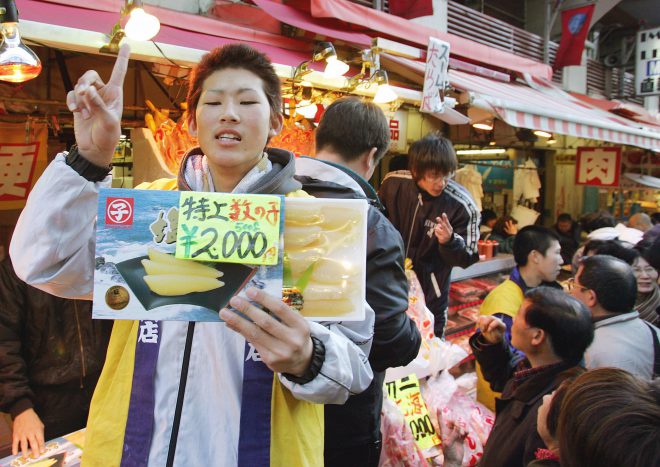Not only for New Year, herring roe promoted for other periods
May 11, 2017
TOKYO- Herring roe is a fixture of traditional New Year's dishes in Japan but demand falls drastically after the holiday season, much to the dismay of local producers and processing industry groups.
In order to sustain demand, they have stepped up promotional efforts, setting their sights on Children's Day on May 5. Regarded in Japan as a symbol of fertility, herring roe is eaten over the New Year's holidays as a form of prayer for the prosperity of descendants. The Japanese word for herring roe, "kazunoko," includes "kazu," which means number, and "ko," or child.
Designating May 5 as a day for herring roe, producers and processors have since last year organized tasting events and sales campaigns during the Golden Week holiday period between late April and early May.
Herring roe is in ready supply in Japan throughout the year thanks to imports, primarily from Canada and the US state of Alaska. Due to its ingrained image as a
New Year's food, however, "sales concentrate disproportionately around the turn of the year," a processor in Hokkaido, northernmost Japan, said.
The Hokkaido federation of seafood processor cooperatives, known as Kakoren, started full-scale sales campaigns last year for seasoned herring roe, which can be eaten without pretreatment such as salt removal, in the hope of stimulating demand for herring roe and putting it on a par with cod and salmon roe, which are both popular throughout the year.
Kakoren held a tasting event at New Chitose Airport in Hokkaido on May 3, along with publicity campaigns at supermarkets, cooperatives and sushi restaurants in many parts of Japan during the holiday period.
Seasoned herring roe retails for about 500 yen per pack of 70 to 100 grams, cheaper than salted herring roe, which is put on the market mainly around the turn of the year.
In addition to seasoned herring roe's low price, industry people highlight a variety of serving ideas. "We recommend eating it as sushi topping or like sashimi," a Kakoren official said.
Some people are concerned that eating a large amount of herring roe may have adverse effects on health due to its high nutritional value.
But according to an analysis by the Canadian Pacific Kazunoko Association, the cholesterol content of herring roe is about half that of salmon roe and some 30 percent lower than that of cod roe. In addition, it was recently discovered that herring roe's content of docosahexaenoic acid, or DHA, and eicosapentaenoic acid, or EPA, which are said to help prevent diseases associated with adult lifestyle habits, exceeds that of Japanese sardine and fatty tuna, both known for their high DHA and EPA content. (Jiji Press)
Latest Videos
- THE UNTOLD STORY EXPERT INSIGHTS INTO THE UKRAINE
- NEGOTIATING A NEW ORDER US RUSSIA TALKS ON UKRAIN
- Ukraine: A Pawn in the Geopolitical Game? Will Trump Intervene?
- US VP VANCE CRITICIZES EUROPEAN DEMOCRACIES AT MUNICH SECURITY CONFERENCE
- UNCOVERING THE WEB OF DECEIT: CIA INFILTRATION OF THE MEDIA
- SHIFTING SANDS: TULSI GABBARD’S CONFIRMATION AND THE EVOLVING GLOBAL LANDSCAPE
- FAUCI SCANDAL: A THREAT TO GLOBAL HEALTH AND DEMOCRACY






